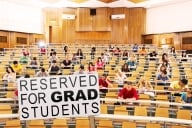You have /5 articles left.
Sign up for a free account or log in.
INDIANAPOLIS -- On what one might call the "vulnerability index" -- how higher education institutions shake out in terms of their financial viability in the short- to mid-term -- the universities represented in a session titled "Remaining Nimble in the Face of External Challenges" at the annual meeting of college business officers here Tuesday are some of the lucky ones.
Unlike some smaller and less-differentiated private and public colleges and universities, public flagship universities like the University of California at Berkeley and the University of Illinois and selective (and highly visible) private institutions like the University of Notre Dame are not only going to survive whatever turmoil higher education faces in the next decade or two -- at least -- they're likely to thrive, too.
But that doesn't mean they can stand pat in the face of the many pressures they (like other colleges and universities) are facing: reduced state appropriations for public institutions, public pressure to control (if not lower) tuition, escalating health care and other costs, and many more. So before a room of 200-plus finance administrators at the National Association of College and University Business Officers, leading officials at Berkeley, Illinois and Notre Dame described how they have been "managing through uncertainty," as Patrice DeCorrevont, national head of higher education banking at JPMorgan Chase, described the environment in which they and everyone else in higher education have been operating.
In general, the strategies the universities laid out align with the view, expressed by a majority of business officers in Inside Higher Ed's recent survey of campus CFOs, that to the extent institutions want to identify funds to invest in strategic priorities, they're going to have to do so by reallocating savings from existing operations rather than finding pots of new revenue. "There are diminished prospects for revenue growth," said DeCorrevont. "Most of the low-hanging fruit was figured out in 2009. What's needed now, by and large, are deeper and more structural changes."
Certainly the public institutions have already changed their student mixes to deal with the wave of budget cutbacks they faced in the wake of the 2008 downturn. As Berkeley saw the proportion of its budget provided by California shrink to 12 percent from nearly 30 percent, it imposed hefty tuition increases (much to the consternation of students) and increased out-of-state enrollment to the state-imposed maximum of 20 percent, said Erin Gore, associate vice chancellor and CFO there. Domestic out-of-state students now make up 14 percent of the enrollment at Illinois's flagship Urbana-Champaign campus -- and international students a whopping 20 percent, said Peter Newman Jr., senior assistant vice president for treasury operations at the Illinois system. (Note: This paragraph has been updated from an earlier version to clarify the makeup of Illinois's enrollment.)
The institutions are exploring other avenues for increasing revenue, but much of the focus now, as the officials described it, is on increasing administrative efficiency to redirect funds to academic and other strategic purposes.
Gore of Berkeley described a philosophy of trying to make "fundamental changes in the things that aren't what make us great" -- information technology, finance, human resources -- to protect and improve the academic and research programs that are at the university's core.
Through the university's "shared services" initiative, it is slowly centralizing campus operations in those functional areas (IT, HR, etc.), and building support for the effort by "tie[ing] changes" to some of the university's top-level priorities, such as strengthening financial aid for low-income and middle-class students, Gore said. "As we move people out of rental space, out of offices, we've demonstrated that they paid for a quarter to half of our middle-class access program." In that vein, Gore said that university officials have sometimes framed their thinking about whether the cost of certain administrative operations can be justified by asking, "Would you want a middle-class family to have to take out a loan to pay for this?" In most cases, that tends to build support for change that might free up funds to help students or for other purposes.
Officials at Notre Dame have also centralized numerous administrative functions, said John Sejdinaj, the vice president for finance there, and made significant changes in purchasing and procurement. The university is now engaging in an exercise aimed at reducing the number of layers between the president and the lowest-level employees in various departments and units, to "take out the middle layers."
The administrators from Berkeley and Illinois also said their institutions were taking a close look at auxiliary service operations such as dining, housing and recreation, reflecting a commonly discussed theme at the business officers' meeting this week. Berkeley's Gore, for instance, said the university had directed its housing operation to ensure that, even as labor costs rise, the prices charged to students do not rise. Many colleges have allowed their room and board charges to rise sharply, even as they try to rein in the tuition prices about which policy makers and the public are becoming more vigilant.









